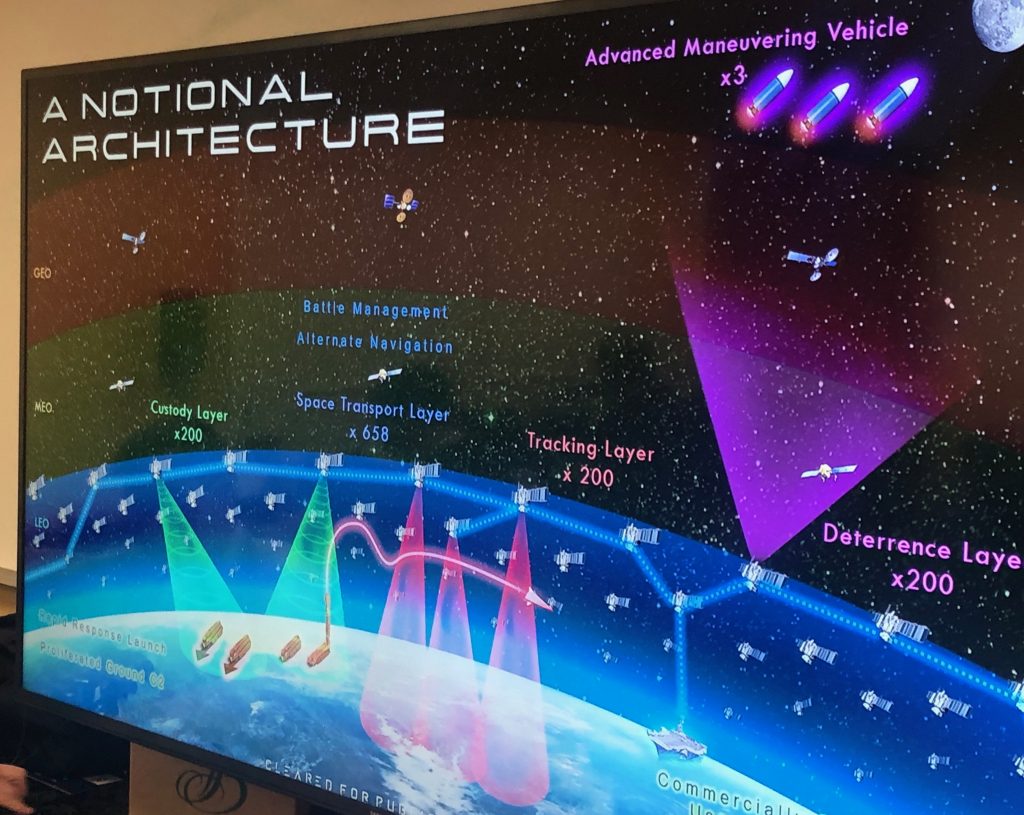SDA Will Control Many Sat Buys, But NOT NROs: Tournear
Posted on

Acting SDA Director Derek Tournear
AFA 2019: The Space Development Agency (SDA) has honed both its mission and acquisition strategy after tumultuous five months, says acting director Derek Tournear. This includes clearly defining when SDA is in charge of satellite development and acquisition, and perhaps more importantly, when it does not. Or at least trying to.
“In the end, Space Development Agency is the ‘orchestrator.’ We are orchestrating the development and fielding of the next-generation national defense space architecture,” he said, cutting what seems to be a wide path across territory that has been occupied by the Air Forces Space and Missile Systems Center. But, as has been the case with all the debate about Space Command, the Space Force and SDA, the devil is in the details.
That SDA architecture was laid out in the original SDA roadmap, unveiled by Kennedy at the 2019 Space Symposium in April. It comprises six space-based “layers” of satellites for differing missions: missile tracking (especially new sats to detect hypersonic missiles); transporting data between satellites and to the ground; a so-called ‘custody’ layer for terrestrial targeting; a battle management layer; an alternate navigation layer that backs up the Global Positioning System (GPS); and a ‘deterrence’ layer for space situational awareness (SSA). There also will be a ground-based layer for data management.

Space Development Agency notional space architecture includes projecting power to cislunar space
SDA will have design and procurement control over some parts of this “proliferated” architecture, he said, including the transport layer in Low Earth Orbit (LEO) that will provide an optically-linked inter-satellite communications backbone. SDA also will be building satellites for space situational awareness (SSA) on threats far away from the Earth, i.e. between Geosynchronous Orbit at 36,000 kilometers above sea level to cislunar orbit.
But here’s the rub. Other critical satellite programs will remain in the hands of the Air Force, other services and, perhaps most importantly, the National Reconnaissance Office (NRO).
“We’re working with lots of other folks, especially the Air Force, to make sure that all of those components necessary for that architecture get built out. We ultimately have the accountability for this proliferated architecture,” Tournear said. But when pressed by reporters at the Air Force Association’s annual conference yesterday, he admitted that having “purview over” the new architecture design is not the same as having “control” over what is bought when and how.
“The Air Force is still doing work for some of their more exquisite systems,” he said, such as those in Medium Earth Orbit (MEO) and GEO, such as Next-Generation Overhead Persistent Infrared (Next-Gen OPIR). Indeed, Tournear explained, SDA will have no control over the various satellites that track and target enemy forces on the ground, including those owned/operated by NRO.
The Air Force will also remain large and in charge of space-based SSA for orbits up to GEO, for example its Geosynchronous Space Situational Awareness Program (GSSAP) satellite constellation. Likewise, the Army and Navy will retain budgetary and programmatic responsibility for their ground- and ship-based sensors that track satellites and feed into the SSA network.
Tournear demurred from answering reporters’ questions about who gets to call the shots if there is a dispute between SDA and the Air Force’s Space and Missile Systems Center (SMC) now responsible for satellite acquisition.
“I don’t want to talk about hypotheticals too much,” he said, adding that SDA is “working very closely” with SMC. “We are the orchestrator for that next-generation architecture. We are the ones that say this is what needs to be done, but we’re not doing that in a way that conflicts right now — we’re doing this in a way that promotes the most synergy.”
Clear as mud, right?
To further complicate matters, Tournear explained that “SDA was set up to have purview of this architecture for the department, specifically excluding the NIP and MIP funding — Title 50 funding. The intel mission (read NRO) is separate.”
That said, he stressed that “obviously we want to be good stewards of taxpayer funding, and in order to do that we’re working very closely with the NRO to make sure that whatever capabilities they are developing are able to plug into our architecture so that they can tie together.” For example, he said, SDA is in discussion with NRO about the transport layer “to see whether they would want to use that for certain communications.”
In addition, the Senate Appropriations Committee wants the Missile Defense Agency (MDA) to have full control of the development of a new missile tracking satellite constellation in LEO that can detect and persistently track hypersonic missiles. The SAC inserted $108 million into the MDA budget for the Hypersonic and Ballistic Tracking Space Sensor (formerly Space Sensor Layer).The SAC also demands that DoD Research and Engineering head Mike Griffin submit a report with the Pentagon’s 2021 budget request that explains how MDA and SDA will work together on that. Those provisions now go to conference with the HAC.
This would clash directly with SDA’s plan that the new agency be the budgeting authority for those satellites, but work closely with MDA.
To old space hands and Breaking D readers, this coordination without control model for the SDA might sound familiar. DoD has experimented over decades with a number of permutations of a “space czar” to coordinate military satellite efforts and, perhaps even more importantly, ground-based receiver programs.
In 2018, then Air Force Secretary Heather Wilson announced she was reviving the Space Architect within Space and Missile Systems Center to match warfighter and strategic intel needs with satellite development. The original National Security Space Architect was folded into the National Security Space Office (NSSO) back in 2004; subsequently the NSSO was abolished in 2010 — both offices essentially failing because while they had responsibility for coordination, they had no budgetary or decision-making authority. In particular, they could not wrangle the insular and fiercely independent NRO in to cooperating with DoD on satellite development and operations.
Now we have SDA as the ‘Space Orchestrator’ with partial budgetary and decision-making authority. In reality, one former Pentagon space hand explained, the only mechanism under the existing structure that gives SDA programming/budgeting control is via Griffin himself, and then only as the budget is built. “That is a very floppy screwdriver,” the source said.
For his part, Tournear said that SDA is different from the old National Security Space Office and its relatives in at least one way that will make a difference in the future. “Those organizations … they weren’t acquisition agencies. It’s a big difference.” He elaborated that the past organizations were policy shops, “tasked with herding the cats,” but they had no acquisition authority. SDA, on the other hand, has authority for building the backbone data link for the entire architecture. “That makes it easier for everyone to say, OK, this is something we all need to plug into and play.”
But notice he also didn’t say that someone, like NRO, could not just say ‘no’ and keep their satellite networks to themselves.
In addition to attempting to clarify SDA’s relationships with other DoD agencies with space portfolios, Tournear said the agency has been working to tweak the plans for the transport layer.
First, instead of looking primarily to to buy commercial capability as a service, SDA now intends to acquire the transport layer satellites the good old fashioned way: developing tailor-made spacecraft via contract. SDA reports to Griffin, who is not a fan of relying on commercial satellite providers. Indeed, it was Griffin’s reluctance to radically change the Pentagon’s space acquisition style that led to the abrupt resignation of SDA’s first director Fred Kennedy.
“We want to take commercial technology that has been developed and spin that on to the DoD, and utilize that,” Tournear said. He stressed that DoD intends to “build and own” the satellites making up the architecture.
Second, SDA will be putting those satellites at 1000 kilometers or so in altitude, rather than the 400k orbital band — a change that Tournear credited to industry advice via SDA’s July 1 request for information (RFI) and subsequent industry day. Moving the altitude will mean developing fewer, slightly bigger (weighing hundreds of kilograms rather than tiny cubesats) satellites.
Tournear acknowledged that there had been “a lot of swirl” that left “people rightly confused” since Kennedy’s departure. But that is behind the agency now, he asserted. SDA successfully has been “evangelizing” the fact that Griffin’s vision for its mission has remained clear and “constant,” both to DoD leadership and Capitol Hill. Tournear cited recent vocal support from Defense Secretary Mark Esper and Air Force Acting Secretary Matt Donovan as evidence that SDA has been “making inroads” in garnering confidence. DoD leadership has spent a good deal of time over recent weeks lobbying Congress on the need for SDA, and Tournear noted that the Senate Appropriations Committee has approved DoD’s fiscal year budget request of $44.7 million for the agency.
Tournear said the agency’s intends to first demo the transport layer satellite design in fiscal 2021; start field testing in 2022 and reach Initial Operating Capability (IOC) in 2024. He estimates some 200 to 400 satellites will be built, each with a five-year lifetime and a development cost between $12 million to $20 million.
Subscribe to our newsletter
Promotions, new products and sales. Directly to your inbox.
